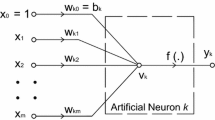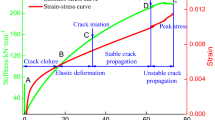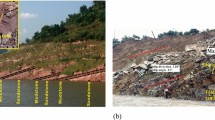Abstract
The peak shear strength of discontinuities between two different rock types is essential to evaluate the stability of a rock slope with interlayered rocks. However, current research has paid little attention to shear strength parameters of discontinuities with different joint wall compressive strength (DDJCS). In this paper, a neural network methodology was used to predict the peak shear strength of DDJCS considering the effect of joint wall strength combination, normal stress and joint roughness. The database was developed by laboratory direct shear tests on artificial joint specimens with seven different joint wall strength combinations, four designed joint surface topographies and six types of normal stresses. A part of the experimental data was used to train a back-propagation neural network model with a single-hidden layer. The remaining experimental data was used to validate the trained neural network model. The best geometry of the neural network model was determined by the trial-and-error method. For the same data, multivariate regression analysis was also conducted to predict the peak shear strength of DDJCS. Prediction precision of the neural network model and multivariate regression model was evaluated by comparing the predicted peak shear strength of DDJCS with experimental data. The results showed that the capability of the developed neural network model was strong and better than the multivariate regression model. Finally, the established neural network model was applied in the stability evaluation of a typical rock slope with DDJCS as the critical surface in the Badong formation of China.










Similar content being viewed by others
References
Adoko AC, Jiao YY, Wu L, Wang H, Wang ZH (2013) Predicting tunnel convergence using multivariate adaptive regression spline and artificial neural network. Tunn Undergr Space Technol 38:368–376
Alemdag S, Gurocak Z, Cevik A, Cabalar A, Gokceoglu C (2016) Modeling deformation modulus of a stratified sedimentary rock mass using neural network, fuzzy inference and genetic programming. Eng Geol 203:70–82
Alshihri MM, Azmy AM, El-Bisy MS (2009) Neural networks for predicting compressive strength of structural light weight concrete.Construction and. Building Materials 23(6):2214–2219
Atapour H, Moosavi M (2014) The influence of shearing velocity on shear behavior of artificial joints. Rock Mech Rock Eng 47(5):1745–1761
Barton N (1973) Review of a new shear strength criterion for rock joints.Engineering. Geology 7(4):287–332
Baum EB, Haussler D (1989) What size net gives valid generalization? Neural Comput 1(1):151–160
Beiki M, Bashari A, Majdi A (2010) Genetic programming approach for estimating the deformation modulus of rock mass using sensitivity analysis by neural network. Int J Rock Mech Min Sci 47(7):1091–1103
Chok YH, Jaksa MB, Kaggwa WS, Griffiths DV, Fenton GA (2016) Neural network prediction of the reliability of heterogeneous cohesive slopes. Int J Numer Anal Methods Geomech 40(11):1556–1569
Choobbasti AJ, Farrokhzad F, Barari A (2009) Prediction of slope stability using artificial neuralnetwork (case study: Noabad, Mazandaran, Iran). Arab J Geosci 2(4):311–319
Cottrell B (2009) Updates to the GG-shear strength criterion. Dissertation, University of Toronto
Chua CG, Goh ATC (2005) Estimating wall deflections in deep excavations using Bayesian neural networks. Tunn Undergr Space Technol 20(4):400–409
Cybenko G (1989) Approximation by superpositions of a sigmoidal function. Math Control Signals Syst 2(4):303–314
Draper NR, Smith H (1981) Applied regression analysis. John Wiley and Sons, New York
Ebrahimi E, Monjezi M, Khalesi MR, Armaghani DJ (2016) Prediction and optimization of back-break and rock fragmentation using an artificial neural network and a bee colony algorithm. Bull Eng Geol Environ 75(1):27–36
Fang K, Wu Q, Wang J, Tan FL (2014) Research on shear characteristics and the evolution mechanism of bedding planes between two different rock types based on particle flow code. Journal of Yangtze River Scientific Research Institute 31(11):31–37 (in Chinese with English Abstract)
Garaga A, Latha GM (2010) Intelligent prediction of the stress–strain response of intact and jointed rocks. Comput Geotech 37(5):629–637
García-Pérez J, Riaño R (2016) Optimum seismic zoning using an artificial neural network. Earthquake Spectra 32(2):1187–1207
Ge ZX, Sun ZQ (2007) Neural network theory and MATLAB R2007 application. Publishing House of Electronics Industry, Beijing
Ghazvinian AH, Taghichian A, Hashemi M, Mar’ashi SA (2010) The shear behavior of bedding planes of weakness between two different rock types with high strength difference. Rock Mech Rock Eng 43(1):69–87
Gokceoglu C, Sonmez H, Kayabasi A (2003) Predicting the deformation moduli of rockmasses. Int J Rock Mech Min Sci 40(5):701–710
Grasselli G, Egger P (2003) Constitutive law for the shear strength of rock joints based on three-dimensional surface parameters. Int J Rock Mech Min Sci 40(1):25–40
Hajihassani M, Armaghani DJ, Marto A, Mohamad ET (2015) Ground vibration prediction in quarry blasting through an artificial neural network optimized by imperialist competitive algorithm. Bull Eng Geol Environ 74(3):873–886
Hencher SR, Richards LR (2015) Assessing the shear strength of rock discontinuities at laboratory and field scales. Rock Mech Rock Eng 48(3):883–905
Huang SM, Wang YY, Ding HM et al. (2016) Norm for seismic design of buildings. China Architecture & Building Press
Jang HS, Jang BA (2015) New method for shear strength determination of unfilled, unweathered rock joint. Rock Mech Rock Eng 48(4):1515–1534
Khaw JFC, Lim BS, Lim LEN (1995) Optimal design of neural networks using the Taguchi method. Neurocomputing 7(3):225–245
Kulatilake PHSW, Wu Q, Hudaverdi T, Kuzu C (2010) Mean particle size prediction in rock blast fragmentation using neural networks. Eng Geol 114(3):298–311
Kulatilake PHSW, Shou G, Huang TH, Morgan RM (1995) New peak shear strength criteria for anisotropic rock joints. International Journal of Rock Mechanics and Mining Sciences &Geomechanics Abstracts 32(7):673–697
Kung TC, Hsiao CL, Schuster M, Juang CH (2007) A neural network approach to estimating excavation-induced wall deflection in soft clays. Comput Geotech 34:385–396
Ladanyi B, Archambault G (1977) Shear strength and deformability of filled indented joints. In: International symposium on the geotechnics of structurally complex formations, Capri, pp317–326
Li CD, Tang HM, Ge YF, Hu XL, Wang LQ (2014) Application of back-propagation neural network on bank destruction forecasting for accumulative landslides in the three gorges reservoir region, China. Stoch Env Res Risk A 28(6):1465–1477
Lian C, Zeng ZG, Yao W, Tang HM (2015) Multiple neural networks switched prediction for landslide displacement. Eng Geol 186:91–99
Mahdevari S, Torabi SR (2012) Prediction of tunnel convergence using artificial neural networks. Tunn Undergr Space Technol 28:218–228
Maier HR, Dandy GC (1998) The effect of internal parameters and geometry on the performance of back-propagation neural networks: an empirical study. Environ Model Softw 13(2):193–209
Majdi A, Beiki M (2010) Evolving neural network using a genetic algorithm for predicting the deformation modulus of rock masses. Int J Rock Mech Min Sci 47(2):246–253
Maji VB, Sitharam TG (2008) Prediction of elastic modulus of jointed rock mass using artificial neural networks. Geotech Geol Eng 26(4):443–452
Maksimovic M (1992) Newdescription of shear strength for rockjoints. Rock Mech Rock Eng 25(4):275–284
Masters T (1993) Practical neural network recipes in C ++. Morgan Kaufmann, SanDiego
Mirzaghorbanali A, Nemcik J, Aziz N (2014) Effects of cyclic loading on the shear behaviour of infilled rock joints under constant normal stiffness conditions. Rock Mech Rock Eng 47(4):1373–1391
Montgomery DC, Peck EA, Vining GG (2006) Introduction to linear RegressionAnalysis. John Wiley & Sons Inc, New Jersey
Ochmański M, Modoni G, Bzówka J (2015) Prediction of the diameter of jet grouting columns with artificial neural networks. Soils Found 55(2):425–436
Papaliangas TT, Hencher SR, Lumsden AC (1995) A comprehensive peakshearstrength criterion for rock joints. In: Fuji T (ed) Proceedings 8th international congress on rock mechanics. Balkema, Tokyo, pp 359–366
Patton FD (1966) Multiple modes of shear failure in rock. In: Proceedings of the 1st congress of ISRM. Lisboa, Portugal, pp 509–513
Polykretis C, Ferentinou M, Chalkias C (2015) A comparative study of landslide susceptibility mapping using landslide susceptibility index and artificial neural networks in the Krios River and Krathis River catchments (northern Peloponnesus, Greece). Bull Eng Geol Environ 74(1):27–45
Rogers LL, Dowla FU (1994) Optimization of groundwater remediation using artificial neural networks with parallel solute transport modeling. Water Resour Res 30(2):457–481
Singh PK, Tripathy A, Kainthola A, Mahanta B, Singh V, Sing TN (2017) Indirect estimation of compressive and shear strength from simple index tests. Eng Comput 33:1–11
Sonmez H, Gokceoglu C, Nefeslioglu HA, Kayabasi A (2006) Estimation of rock modulus: for intact rocks with an artificial neural network and for rock masses with a new empirical equation. Int J Rock Mech Min Sci 43(2):224–235
Sow D, Rivard P, Peyras L, Breul P, Moradian ZA, Bacconnet C, Ballivy G (2015) Comparison of joint shearing resistance obtained with the barton and choubey criterion and with direct shear tests. Rock Mech Rock Eng 49(8):3357–3361
Tang ZC, Jiao YY, Wong LNY, Wang XC (2016) Choosing appropriate parameters for developing empirical shear strength criterion of rock joint: review and new insights. Rock Mech Rock Eng 49(11):4479–4490
Tang ZC, Wong LNY (2016) Influences of normal loading rate and shear velocity on the shear behavior of artificial rock joints.Rock. Mechanics and Rock Engineering 49(6):2165–2172
Widrow B (1987) Adaline and madaline 1963: Plenary speech. In: Proceedings of 1st IEEE international conference on neural networks, SanDiego, pp 143–158
Wu YW (2012) Software engineering and knowledge engineering: theory and practice. Springer Science & Business Media
Xie H, Pariseau WG(1992) Fractal estimation of the joint roughness coefficients. In:Proceedings of international conference on fractured and jointed rock masses, Balkema, Rotterdam, pp 125–131
Acknowledgements
The research was funded by the National Key R&D Program of China (2017YFC1501301) and Natural Science Foundation of Hubei province of China (2018CFB666). The authors are grateful to the organization s that provided the aforementioned financial support.
Author information
Authors and Affiliations
Corresponding author
Ethics declarations
Conflict of interest
The authors declare that they have no conflict of interest regarding the publication of this paper.
Appendix 1
Appendix 1
Rights and permissions
About this article
Cite this article
Wu, Q., Xu, Y., Tang, H. et al. Peak shear strength prediction for discontinuities between two different rock types using a neural network approach. Bull Eng Geol Environ 78, 2315–2329 (2019). https://doi.org/10.1007/s10064-018-1290-x
Received:
Accepted:
Published:
Issue Date:
DOI: https://doi.org/10.1007/s10064-018-1290-x




